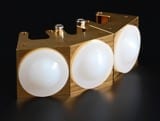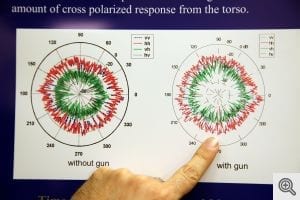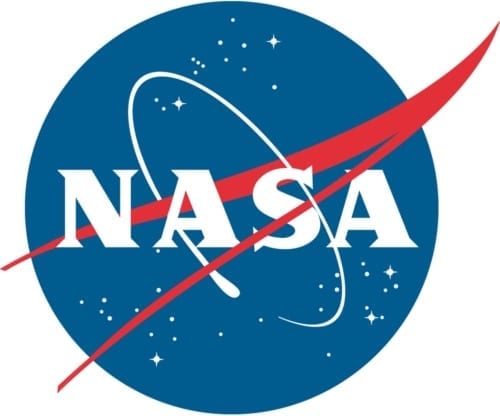
Suitable for a broad range of applications, from traffic controls and medical technology to logistics and industrial sensor technology
The human eye cannot see through wood, paper, or plastic. But a compact radar with a modular design now makes it possible to see the invisible: The millimeter wave sensor penetrates non-transparent material. It transmits signals at frequencies between 75 and 110 GHz and can be applied in a broad range of areas, from flight safety and logistics to industrial sensor technology and medical technology. Fraunhofer researchers are presenting a prototype of the radar at this year‘s Hannover Messe, which is set to take place from April 8 to April 12. They will be located at Stand D18 in Hall 2.
The mountain rescue helicopter is moving very slowly and carefully toward to the scene of an accident. A few minutes ago, two snow-shoers placed an emergency call to the base. One of two men was injured and unable to walk back down the mountain. Very carefully, the pilot begins to land. This is a risky maneuver, as freshly fallen snow makes the approach difficult. The rotor downwash causes the soft, loose snow to swirl upward. Within seconds, a cloud of snow surrounds the helicopter. In whiteouts like these, pilots lose their reference points and cannot tell whether the helicopter is moving upward or downward. Such difficult landing maneuvers will soon be issue of the past: researchers at the Fraunhofer Institute for Applied Solid State Physics IAF, for Manufacturing Engineering and Automation IPA, and for Reliability and Microintegration IZM are working together to develop a radar that can provide landing support in all ambient conditions. Whether in snow clouds, dust, or fog, the radar is capable of measuring exact heights and distances to the ground. This radar works with millimeter waves at frequencies of 75 to 110 GHz, usually known as the W-band. Even in situations of difficult visibility, it can identify small objects at a range of up to 3 kilometers. In contrast to optical sensors, the millimeter wave sensor is capable of penetrating all dielectrical, non-metallic and non-transparent materials, such as clothing, plastic surfaces, paper, wood, or even snow and fog.
This makes the W-band radar suitable for a broad range of applications, from traffic controls and medical technology to logistics and industrial sensor technology. This includes, for instance, the monitoring of container ports or manufacturing processes. “The W-band radar can be used in any situation where other sensor technologies in manufacturing processes have failed because of high temperatures or limited visibility. Just to name one example, it can be used as a filling level sensor in flour silos: a great deal of dust forms when they are being filled,“ says Dr. Axel Hülsmann, an engineer at IAF. And the device has other advantages as well: in contrast to x-ray scanners, it does not pose a health hazard, and it works with short-wave beams in the millimeter range. It has a transmission power of 10 milliwatts, compared with the 1000-milliwatt range of a mobile phone.
About the size of a cigarette box
Existing radar systems, which are based on ceramic substrates, are expensive, large, and weigh four to five kilograms. This limits where they can be deployed, and they are mainly used for military applications. In contrast, the new system that Fraunhofer researchers have developed has a modular design and is cost-effective. In addition, it is more energy efficient, has a higher resolution, and can be universally applied. The new technology presents no problems when required to address frequencies exceeding 100 GHz.
Thanks to the short wave-lengths of approximately three millimeters, the W-band radar is compact in size. The complete system, which is made of gallium arsenide semiconductor technology, is about the size of a cigarette box. In addition to handling digital signal traffic, the box contains a high-frequency module, a signal processor, as well as a transmission and reception antenna with dielectric lenses. “Since we are using a dielectric antenna, the angle of aperture can be freely selected. This means recorded data can cover a close-up of large surfaces just as easily as small, far away objects,“ says Hülsmann. This makes it possible to monitor a fence that is several hundred meters long, like the ones at Hamburg‘s container port. “When there is fog, as is often the case at Hamburg’s port on the Elbe River, security cameras are unable to deliver high-resolution images. This is why the authorities often patrol with dog units when the weather is bad,“ the researcher explains.
The Latest Bing News on:
W-band radar
- Advanced Technologies Pave the Way for New Phased Array Radar Architectureson May 15, 2024 at 3:20 pm
The objective of a digital beamforming phased array is the simultaneous generation of many antenna patterns for a single set of receiver data. Figure 3 shows the antenna patterns at an element, the ...
- Publications 2011on May 6, 2024 at 4:59 pm
[2] T. Le Toan, S. Quegan, M. Davidson, H. Baltzer, Philippe Paillou, Konstantinos Papathanassiou, S. Plummer, F. Rocca, S. Saatchi, H. Shugart and L. Ulander The ...
- UK explores new radar and IR tech to enhance SDAon April 25, 2024 at 5:00 pm
Dstl is investigating the development of an inverse synthetic aperture radar for the characterisation of objects in low Earth orbit (LEO). One of the technologies being assessed is a W-band gyro ...
- NASA's CloudSat ends mission peering into the heart of cloudson April 22, 2024 at 4:59 pm
When launched in 2006, the mission's Cloud Profiling Radar was the first-ever 94 GHz wavelength (W-band) radar to fly in space. A thousand times more sensitive than typical ground-based weather ...
- Submillimeter-Wave Technology Laboratoryon August 4, 2023 at 12:23 pm
STL also serves as a prime contractor on a US Army radar program delivering direct government support in UHF-band thru W-band target signature acquisition, radar range design/construction, ...
- Kennedy College of Scienceson January 28, 2022 at 1:04 pm
He has developed, implemented and published a number of advances in submillimeter radar modeling technology. Among these advances are the design of polarimetric measurement systems, the generation of ...
- Signature Study for Vehicle-Animal Collision Avoidance (VACA)on July 25, 2020 at 2:47 pm
In spring 2014, MTRI collected hundreds of thousands of measurements of whitetail deer with the RADAR/LIDAR sensor suite. The W-Band RADAR is operating at 76.2 to 76.8 GHz and the LIDAR sensor is ...
- Characterization of Automotive Radar Reflectivity for W-Band Systemson July 24, 2020 at 5:47 am
The vehicles were measured with a radar at W-band with an antenna set at a height of 45 cm, typical for automotive radar, and scanned in azimuth across the rear end of the vehicles from a range of 40 ...
- On 5G And The Fear Of Radiationon April 8, 2020 at 12:16 am
This is why standing in the sunshine, or in front of an infrared (IR) heating lamp, or an operating radar dish makes one feel warm. What we perceive as ‘heat’ radiating off objects is mostly ...
- Clouds and Precipitation Observation and Researchon October 17, 2018 at 4:38 am
Jackson, R., J. R. French, D. C. Leon, D. M. Plummer, S. Lasher-Trapp, A. M. Blyth, and A. Korolev, 2018: Observations of the microphysical evolution of convective ...
The Latest Google Headlines on:
W-band radar
[google_news title=”” keyword=”W-band radar” num_posts=”10″ blurb_length=”0″ show_thumb=”left”] [/vc_column_text]The Latest Bing News on:
New radar
- Stock Radar: JSW Steel, Zydus Life, Bandhan Bank, Zee Entertainment in focus todayon May 18, 2024 at 2:04 am
Let's catch up on the latest news from the stock market. From significant investments to major deals and earnings announced on May 17 to earnings announcements expected today, here's a quick look at ...
- D.C.-area forecast: Another damp and cool Saturday, then some improvement on Sundayon May 18, 2024 at 2:00 am
3/10: Another cool Saturday with rain and drizzle. Been there, done that. Today: Areas of rain through midday, then lighter showers/drizzle. Highs: Near 60 to mid-60s. Tonight: Spotty shower, drizzle, ...
- Advancing Rider Safety: Honda's New Radar Technology Aims To Elevate Motorcycle Safetyon May 17, 2024 at 11:51 pm
Honda is advancing radar and camera technology for motorcycles to boost safety, testing adaptive cruise control on the Africa Twin for a safer ride.
- Weather Forecast: Showers and Storms Around This Weekendon May 17, 2024 at 11:45 pm
Extended: Rain chances gradually go down into next week as temperatures creep up.
- After Claiming Cameras Could Replace Radar, Tesla Is Working on Radar Againon May 17, 2024 at 7:14 pm
Jalopnik, it seems that request with the FCC back in June points to frequency-modulated continuous wave (FMCW) radar ends up being more accurate than pulsed systems a laser-based radar system that ...
- 'Boring is good' — Michigan tax revenues stable in new forecaston May 17, 2024 at 3:40 pm
Michigan will see "healthy" job growth over the next three years, an average of 36,000 annually, with the growth concentrated outside the manufacturing sector, according to University of Michigan ...
- Multiple rounds of storms bring threats of severe weather and flooding in your New Orleans weather forecaston May 15, 2024 at 4:43 pm
We'll end the week with multiple rounds of possible severe storms and heavy rain in your New Orleans weather forecast.For an in depth analysis on the potential of severe storms and heavy rain from ...
- Degrees of Science: Groundbreaking New Weather Radaron May 15, 2024 at 12:44 pm
(KWTX) -This week we are talking with Dr. Robert Palmer, the Executive Director of the Advanced Radar Research Center at the University of Oklahoma, about their new Horus Radar. The Horus Radar ...
- The New A-Team: Why Current STEM Students and Graduates Should be on Your Hiring Radaron May 15, 2024 at 6:11 am
Current college students and recent graduates in STEM (Science, Technology, Engineering, and Mathematics) represent a critical talent pool for building AI into a company's future culture. Their fresh ...
- What an NWS radar would mean for Charlotteon May 15, 2024 at 6:00 am
Charlotte is one of the largest cities in the country without a National Weather Service radar. But Congressman Jeff Jackson hopes to change that with a bill he introduced that would give areas like ...
The Latest Google Headlines on:
New radar
[google_news title=”” keyword=”new radar” num_posts=”10″ blurb_length=”0″ show_thumb=”left”]











